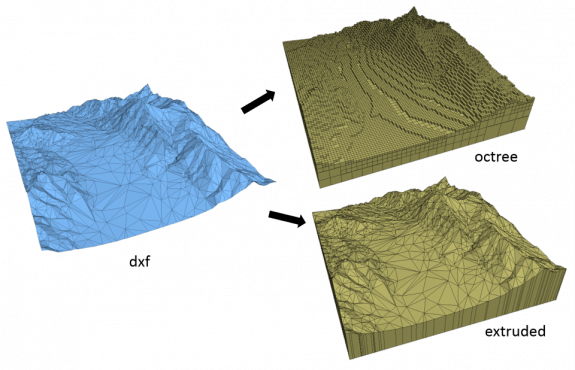In a previous post, we showed an example of how a topography could be modeled in 3DEC using the ‘octree’ approach. First, a geometry surface is imported (e.g., a dxf file) and a small number of blocks are created. Then, each block that is touching the geometry surface is split into eight smaller blocks. This continues until there is a satisfactory representation of the surface geometry (see the figure below). The downside of this approach is that the ‘stair-step’ mesh is fairly unattractive and sometimes there is spurious failure at the sharp corners of these cubic blocks. It also can lead to a lot of blocks (26,000 in the plot below).
A much better representation of the surface can be obtained using Kubrix Geo. This software can generate a tetrahedral mesh to match exactly to a desired topography (or any other geometry). The advantage of Kubrix is that it can mesh intersecting surfaces, tunnels, geological units, and even non-planar faults.
However, if you are interested only in representing a topography, or perhaps a few non-intersecting horizons, there is another way. You can import the geometry surface and then extrude each polygon that makes up the surface using the POLY PRISM command in 3DEC. This requires a bit of FISH (see link below), but the result is worth it. You can see in the plot below that not only is the surface much smoother than the octree surface, there also are significantly fewer blocks (3,300 in the plot below). The downside is that some of these blocks may have problematic geometries (e.g., high aspect ratios). This can be mitigated somewhat by ensuring that you have a good mesh and by making some horizontal cuts. Identifying and dealing with bad blocks will covered in a future post.
Revised - July 02, 2016. Set atol to 0.1 to prevent geometry errors.

Download example
